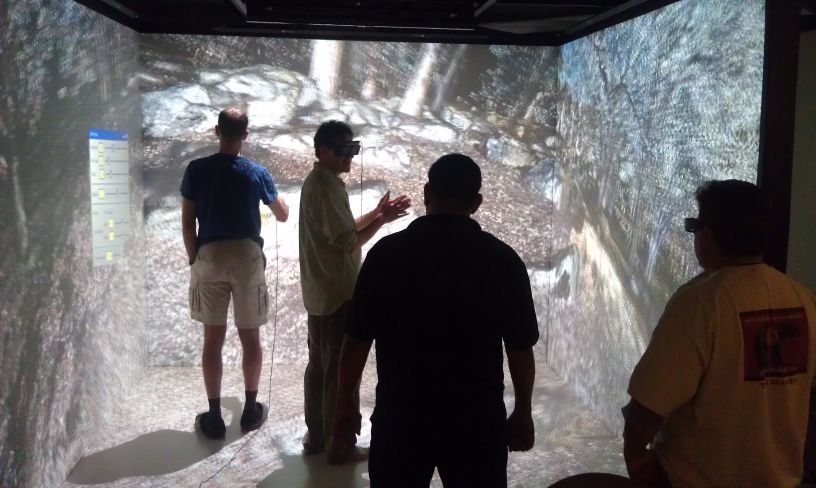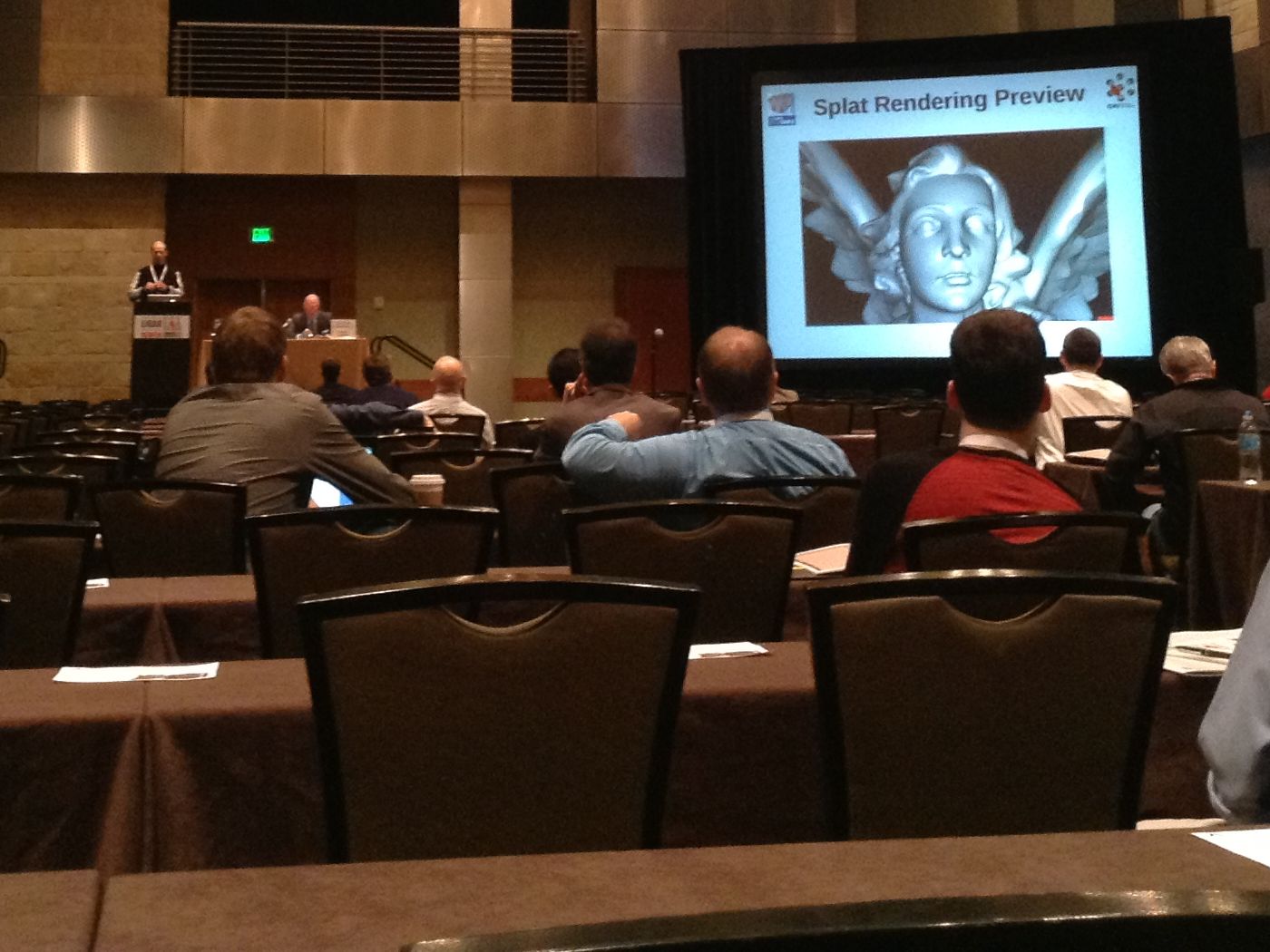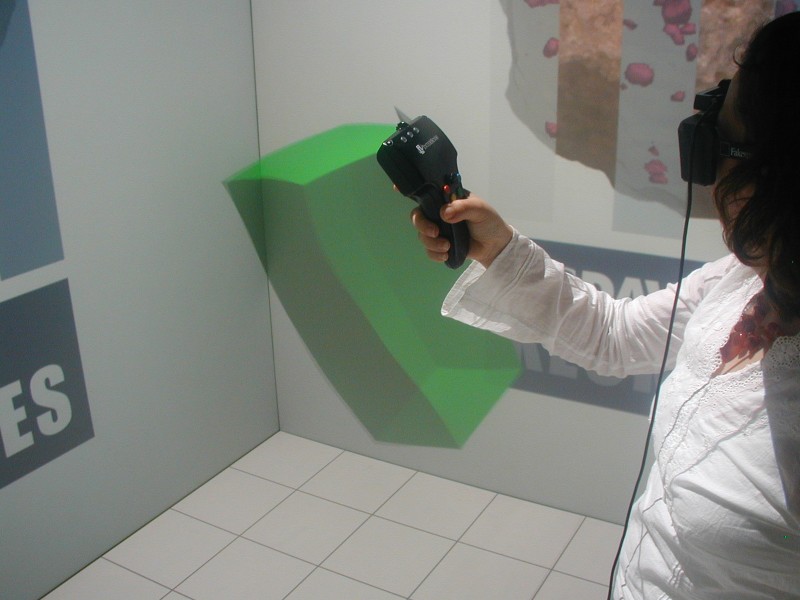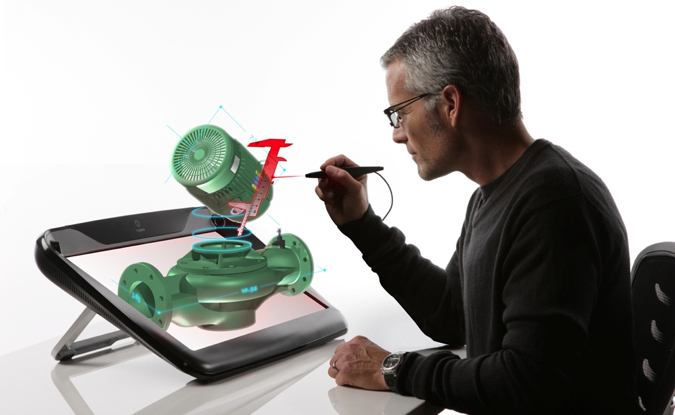I went to the Sacramento Hacker Lab last night, to see a presentation by Intel about their soon-to-be-released “perceptual computing” hardware and software. Basically, this is Intel’s answer to the Kinect: a combined color and depth camera with noise- and echo-cancelling microphones, and an integrated SDK giving access to derived head tracking, finger tracking, and voice recording data.
Tag Archives: 3d displays
Low-cost VR for materials science
In my ongoing series on VR’s stubborn refusal to just get on with it and croak already, here’s an update from the materials science front. Lilian Dávila, former UC Davis grad student and now professor at UC Merced, was recently featured in a three-part series about cutting-edge digital research at UC Merced, produced by the PR arm of the University of California. Here’s the 10-minute short focusing on her use of low-cost holographic displays for interactive design and analysis of nanostructures:
KeckCAVES on Mars, pt. 4
I mentioned before that we had a professional film crew in the CAVE a while back, to produce promotional video for the University of California‘s “Onward California” PR program. Finally, the finished videos have been posted on the Office of the President’s official YouTube channel. Unlike my own recent CAVE videos, these ones have excellent audio.

Figure 1: Dawn Sumner, member of the NASA Curiosity Mars rover mission’s science team, interacting with a life-size 3D model of the rover in the UC Davis KeckCAVES holographic display environment. Still image taken from “The surface of Mars.”
These short videos focus on Dawn Sumner, a professor in the UC Davis Department of Geology, and a KeckCAVES core member. This time, Dawn is wearing her hat as a planetary explorer and talking about NASA‘s Curiosity Mars rover mission, and her role in it.
Of CAVEs and Curiosity: Imaging and Imagination in Collaborative Research
On Monday, 03/04/2013, Dawn Sumner, one of KeckCAVES‘ core members, gave a talk in UC Berkeley‘s Art, Technology, and Culture lecture series, together with Meredith Tromble of the San Francisco Art Institute. The talk’s title was “Of CAVEs and Curiosity: Imaging and Imagination in Collaborative Research,” and it can be viewed online (1:12:55 total length, 50 minutes talk and 25 minutes lively discussion).
While the talk is primarily about the “Dream Vortex,” an evolving virtual reality art project led by Dawn and Meredith involving KeckCAVES hardware (CAVE and low-cost VR systems) and software, Dawn also touches on several of her past and present scientific (and art!) projects with KeckCAVES, including her work on ancient microbialites, exploration of live stromatolites in ice-covered lakes in Antarctica, our previous collaboration with performing artists, and — most recently — her leadership role with NASA‘s Curiosity Mars rover mission.
The most interesting aspect of this talk, for me, was that the art project and all the software development for it, are done by the “other” part of the KeckCAVES project, the more mathematically/complex systems-aligned cluster around Jim Crutchfield of UC Davis‘ Complexity Sciences Center and his post-docs and graduate students. In practice, this means that I saw some of the software for the first time, and also heard about some problems the developers ran into that I was completely unaware of. This is interesting because it means that the Vrui VR toolkit, on which all this software is based, is maturing from a private pet project to something that’s actually being used by parties who are not directly collaborating with me.
On the road for VR part II: Tahoe Environmental Research Center, Incline Village, Lake Tahoe
We have been collaborating with the UC Davis Tahoe Environmental Research Center (TERC) for a long time. Back in — I think — 2006, we helped them purchase a large-screen stereoscopic projection system for the Otellini 3-D Visualization Theater and installed a set of Vrui-based KeckCAVES visualization applications for guided virtual tours of Lake Tahoe and the entire Earth. We have since worked on joint projects, primarily related to informal science education. Currently, TERC is one of the collaborators in the 3D lake science informal science education grant that spawned the Augmented Reality Sandbox.
The original stereo projection system, driven by a 2006 Mac Pro, was getting long in the tooth, and in the process of upgrading to higher-resolution and brighter projectors, we finally convinced the powers-that-be to get a top-of-the line Linux PC instead of yet another Mac (for significant savings, one might add). While the Ubuntu OS and Vrui application set had already been pre-installed by KeckCAVES staff in the home office, I still had to go up to the lake to configure the operating system and Vrui to render to the new projectors, update all Vrui software, align the projectors, and train the local docents in using Linux and the new Vrui application versions.
Immersive visualization for archaeological site preservation
Have I mentioned lately that VR is not dead yet, and instead thinks it’ll be going for a walk? Here’s more proof. One of KeckCAVES‘ external users, Marshall Millett, archaeologist and GIS expert, is using high-resolution 3D scanning, based on LiDAR or white-light scanning, to capture and digitally preserve cultural heritage sites, such as the Maidu Indian Museum’s historic site and trail (close to Roseville, CA).

Figure 1: Danny Rey, Tribal Historic Preservation Officer, and Marcos Guerrero, Cultural Resources Manager, representatives of the United Auburn Indian Community, viewing a high-resolution 3D scan of the Maidu Historic Trail and Site in the KeckCAVES immersive visualization facility. In the background Joe Dumit of UC Davis’ Science and Technology Studies, and myself. Photo provided by Marshall Millett.
Marshall has been using KeckCAVES software, particularly LiDAR Viewer (about which I should really write a post), and also the KeckCAVES facility itself and related technology, to visualize his high-resolution 3D models at 1:1 scale, and with the ability to experience them in ways that are not normally possible (most of these sites are fragile and/or sacred, and not available to the public). Part of this work were several visits of community representatives to the KeckCAVES facility, to view their digitally reconstructed historic site (see Figure 1).
Marshall presented a poster about his work at last year’s 3D Digital Documentation Summit, held July 10-12, 2012 at the Presidio, San Fransisco, CA, and was just interviewed for a podcast by the National Center for Preservation Technology and Training (where, as of 02/21/2013, KeckCAVES prominently features on the front page).
First VR environment in Estonia powered by Vrui
Now here’s some good news: I mentioned recently that reports of VR’s death are greatly exaggerated, and now I am happy to announce that researchers with the Institute of Cybernetics at Tallinn University of Technology have constructed the country’s first immersive display system, and I’m prowd to say it’s powered by the Vrui toolkit. The three-screen, back-projected display was entirely designed and built in-house. Its main designers, PhD student Emiliano Pastorelli and his advisor Heiko Herrmann, kindly sent several diagrams and pictures, see Figures 1, 2, 3, and 4.
On the road for VR (sort of…): ILMF ’13, Denver, CO
I just returned from the 2013 International LiDAR Mapping Forum (ILMF ’13), where I gave a talk about LiDAR Viewer (which I haven’t previously written about here, but I really should). ILMF is primarily an event for industry exhibitors and LiDAR users from government agencies or private companies to meet. I only saw one other person from the academic LiDAR community there, and my talk stuck out like a sore thumb, too (see Figure 1).
How head tracking makes holographic displays
I’ve talked about “holographic displays” a lot, most recently in my analysis of the upcoming zSpace display. What I haven’t talked about is how exactly such holographic displays work, what makes them “holographic” as opposed to just stereoscopic, and why that is a big deal.
ZSpace: a turn-key holographic display
I’ve been waiting for this for such a long time: a turn-key stereoscopic display with built-in pre-calibrated head tracking and tracked input device. We’ve been in the low-cost VR business for more than four years now, but the biggest problem is that our reference design is entirely DIY. Users have to go out and buy individual components, assemble them, and then — most importantly — calibrate them with respect to each other. This calibration step is the biggest hurdle for low-cost VR’s acceptance, because the idea behind it is somewhat hard to understand for VR non-experts, and even if it’s understood, it still requires expensive non-standard tools.
The solution, of course, is simple: instead of having the display and tracking system as separate entities that need to be calibrated with respect to each other, integrate them into the same frame, and pre-calibrate them at the factory. The only thing that had to happen was for a manufacturer to step up to the plate and make it so.
Voilá, I present the zSpace holographic display (see Figure 1).






